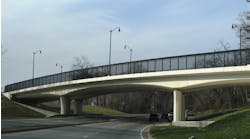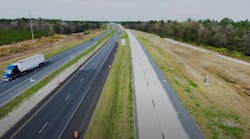Just a few miles north of the U.S. border, Mission, British Columbia-based Camwood Construction Ltd. is making a name for itself.
This young, energetic and up-and-coming general contractor travels western Canada, completing concrete infrastructure projects such as civil, commercial, mining and oil fields.
The company’s passion, according to owner Jeremy Woodman, is bridges. “We started the company seven years ago,” he said, “with the vision of bridge building.” The company handles all facets of bridge construction from the ground up, with the one exception of deck paving. “We would sub out the deck paving to a local contractor,” he continued.
This business model worked well for the company for several years, even though there were some drawbacks. For instance, there was no consistency in the model and capabilities of the bridge-paving equipment from job to job. Sometimes this forced the company to inefficiently pave a deck in two pours when it could have been paved in one.
“We recently paved two bridges in Kelowna, B.C.,” said Jevin Viesulas, site superintendent for Camwood, “and the larger of the two was paved in two pours,” since the bridge paver was not wide enough to pave it in one.
It was this inflexibility and a large bridge project in Calgary that prompted Camwood to reassess its practice of subcontracting the deck paving.
A perfect match
Woodman recalled much back-and-forth deliberation on whether to purchase a deck paver or continue with the model of subcontracting. For bridge structure construction, the company used a rental strategy for the larger pieces of equipment, like cranes, required to complete the job.
“We analyzed where we were going as a company,” said Woodman. “Bridge construction is our passion, and the biggest bang for our buck was purchasing a deck machine.”
Tony Regina, Camwood’s site superintendent for the Calgary Southeast Stoney Trail project, had his own set of specific needs for a new bridge paver.
“We needed a machine capable of paving at least 120 ft wide,” he said. “Additionally, I wanted a durable paver and one that would give us the flexibility to pave difficult bridge decks built at a skew angle with a crown.”
Camwood purchased the Terex Bid-Well 4800 paver with sights set on using the machine to first pave in Calgary. The machine was delivered to Camwood’s headquarters in Mission in September, and crews prepped it for the trip to Alberta.
“We had anticipated pouring two decks this fall on the Southeast Stoney Trail project,” explained Woodman.
A delay at the Calgary construction site, however, gave Camwood the opportunity to use its recently purchased bridge-deck paver in Kelowna to improve paving efficiency. The decision to divert the paver to this project a little closer to home turned out to be a bit of a saving grace for the company.
Going solo
The small bridge deck that was to be Camwood’s first paving attempt was one of two bridges the contractor constructed on Kelowna’s Highway 97. They subcontracted paving of the first and larger bridge deck. It was a straight 90-ft-wide by 130-ft-long deck with cross fall of 4.8%, grade of 5%, a superelevation and spiral.
Unfortunately, the subcontractor’s 1980s-vintage bridge-deck paver had no frills and could not be extended wide enough to pave the entire 90-ft deck width at one time. So, crews had to make adjustments and additional preparations for two pours.
“We built and dismantled a bulkhead, ran additional dry runs and had the crews and equipment on the deck two separate days for the pours,” recalled Viesulas. Had the paver been wide enough to pour the deck in one pass, “it would have saved us about a week’s time.”
One other drawback, the older paver was not able to handle the 5% grade it was paving without slipping. Crews used cable turfers to help the paver advance on the rail.
Initially, Camwood planned to subcontract the smaller bridge-deck paving to the same company that paved the larger bridge. The deck measured a mere 75 ft wide by 82 ft long. Had the deck been able to be paved straight, the older paver would have been able to pave the full deck width in one pass.
However, the structure was built at a 35º skew angle with a 2% crown either side of center.
“On the skew, the crown measured 4.8% and 1.8%,” said Viesulas. Paving at the skew, the preferred method by the Ministry of Transportation, meant the paver would have to be set at 90 ft wide to compensate for the skew.
This additional length meant the subcontractor’s paver would, once again, be too short to pave the full width of the deck in one pass. The crew would again have to take the additional steps associated with paving two pours.
“If we can pave a deck in one pour versus two, this saves us $10,000 to $20,000,” added Viesulas.
Had the old paver been long enough to pave at the skew angle, it still wouldn’t have been able to pave the deck in one pour.
“The other paver did not have a skew bar kit to compensate for the crown,” said Viesulas.
Rodriguez added, “When paving at the skew, the crown runs through the frame at different points from the front to the rear of the machine.”
Increasing the complexity of the pour, the deck had a 5% grade, so from previous experience the crews had cable turfers ready to assist. Additionally, the 72-ft-long girders had a 3.5-in. camber, so concrete had to be loaded evenly to achieve the required deck smoothness. Commenting on the complexity of the paving application and Camwood’s desire for this to be its first solo deck paving job, Rodriguez likened it to teaching a 16-year-old how to drive on a stick shift of an 18-wheeler.
Regardless of these immense challenges, Camwood sent the 4800 to Kelowna. Camwood’s crews set the bridge paver’s width to 90 ft, paving at the skew so the entire deck could be poured at one time.
“Paver assembly is straightforward, and it’s easy to string line the machine, even with the crown,” said Viesulas.
In the morning hours of October 25, 2012, Camwood started the pour of its first solo deck-paving job. The 4,950 cu ft of concrete was brought to the jobsite in 210-cu-ft loads and pumped onto the deck. The stiff, 5,000-psi concrete was sent to the paving site at a dry 2-in. slump.
Camwood’s crews set a paving productivity goal of 880 to 1,060 cu ft per hour. Within 4.5 hours, the crew put the finishing touches on the bridge deck.
“We stuck to the upper end of our paving goal with the [bridge-deck paver],” mentioned Viesulas.
The new paver was able to easily handle the grade without the assistance of the cable turfers.
While the crew wanted to work fast, they did not sacrifice quality. Smoothness specifications called for no greater than 3-mm variation for every 6 ft traveled.
“We had no issue meeting the ride specification,” said Viesulas. He also attributed a beautiful looking surface finish to the 4800’s patented Rota-Vibe system.
“It really left a nice finish on the back end, and our finishers had less work to do.”
Beyond cosmetics, being able to pave the complicated deck in one pour helped to improve the deck’s longevity. This way of paving eliminated a joint at the bulkhead, which would have been required had the deck been paved in two pours.
“The bridge inspector,” said Viesulas, “initially doubted the deck could be paved in one pour. After we finished, he was all for paving it at one time.”
With the company’s first solo paving job and this challenging little bridge deck out of the way, the bridge-deck paver is being sent to Calgary in preparation for paving three bridge decks next spring on the Southeast Stoney Trail project. Passing the test of their first trial-by-fire project, Camwood’s crew should have no problem with those decks. R&B


